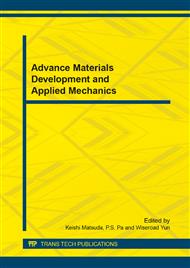[1]
Ashby, M.F., et al., Metal Foams: A Design Guide. 2000: Butterworth-Heinemann.
Google Scholar
[2]
Fiedler, T., et al., Numerical analyses of the thermal conductivity of random hollow sphere structures. Materials Letters, 2009. 63(13): pp.1125-1127.
DOI: 10.1016/j.matlet.2008.10.030
Google Scholar
[3]
Öechsner, A. and C. Augustin, Multifunctional Metallic Hollow Sphere Structures. Multifunctional Metallic Hollow Sphere Structures: Manufacturing, Properties and Application, Engineering Materials, 2009. 1.
DOI: 10.1007/978-3-642-00491-9
Google Scholar
[4]
Pannert, W., R. Winkler, and M. Merkel, On the acoustical properties of metallic hollow sphere structures (MHSS). Materials Letters, 2009. 63(13-14): pp.1121-1124.
DOI: 10.1016/j.matlet.2008.10.063
Google Scholar
[5]
Conde, Y., et al., Replication processing of highly porous materials. Advanced Engineering Materials, 2006. 8(9): pp.795-803.
Google Scholar
[6]
Fiedler, T., et al., Mechanical properties of aluminium foam derived from infiltration casting of salt dough. Computational Materials Science, 2014. 81: pp.246-248.
DOI: 10.1016/j.commatsci.2013.08.021
Google Scholar
[7]
ISO 13314: 2011(E) Mechanical testing of metals — Ductility testing — Compression test for porous and cellular metals. (2011).
DOI: 10.3403/30203544u
Google Scholar
[8]
Veyhl, C., et al., Thermal analysis of aluminium foam based on micro-computed tomography. Materialwissenschaft und Werkstofftechnik, 2011. 42(5): pp.350-355.
DOI: 10.1002/mawe.201100787
Google Scholar
[9]
Sulong, M.A., et al., Compressive properties of Advanced Pore Morphology (APM) foam elements. Materials Science and Engineering: A, (0).
DOI: 10.1016/j.msea.2014.04.037
Google Scholar
[10]
Veyhl, C., et al., On the thermal conductivity of sintered metallic fibre structures. International Journal of Heat and Mass Transfer, 2012. 55(9-10): pp.2440-2448.
DOI: 10.1016/j.ijheatmasstransfer.2012.01.016
Google Scholar
[11]
Vesenjak, M., et al., Structural Characterisation of Advanced Pore Morphology (APM) Foam Elements. Materials Letters, (2013).
DOI: 10.1016/j.matlet.2013.08.026
Google Scholar
[12]
Fiedler, T., et al., On the Anisotropy of Lotus-Type Porous Copper. Advanced Engineering Materials, 2011. 14(3): pp.144-152.
Google Scholar
[13]
Holt, J.M., H. Mindlin, and C.Y. Ho, Structural alloys handbook. 1995: CINDAS/Purdue University.
Google Scholar
[14]
Veyhl, C., et al., On the mesh dependence of non-linear mechanical finite element analysis. Finite Elements in Analysis and Design, 2010. 46(5): pp.371-378.
DOI: 10.1016/j.finel.2009.12.003
Google Scholar
[15]
Sulong, M. and A. Öchsner, Finite element simulation of the macroscopic heat conductivity of syntactic perforated hollow sphere structures. Materialwissenschaft und Werkstofftechnik, 2012. 43(5): pp.461-467.
DOI: 10.1002/mawe.201200982
Google Scholar


